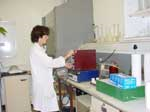Though a person may be suspected of having porphyria on clinical grounds, a diagnosis must never be based solely on symptoms, signs or a family history. Furthermore, it is important to realise that the clinical effects of porphyria are variable, and the diagnosis must always be confirmed in the laboratory.
Here we describe the various tests available for porphyria diagnosis. (A separate page, Diagnosing porphyria, will tell you more specifically which tests a patient requires, as this is dependent on their history.)
Diagnostic tests for porphyria may be divided into 2 classes.
Biochemical Tests
Plasma fluorescence scanning
Currently, for the diagnosis of variegate porphyria (VP), we make extensive use of the plasma fluoresence scan. This is a test in which a blood sample is analysed for a specific fluorescence peak, the wavelength of which depends on the identity of the porphyrins present in the blood, which again depends on the type of porphyria present. In VP, the peak is at 625 nm, in EPP, at 630 nm, and in AIP and PCT, at 619 nm.
Chromatography
Samples of urine, stool and/or blood are analysed for their porphyrin content by a process of quantitative chromatography. Simple screening tests and non-quantitative thin-layer chromatography, are unacceptable in view of a high rate of false-positive and false-negative results.
Enzyme assay
In such a test, the activity of a specific enzyme of the haem synthetic pathway associated with the suspected porphyria is tested. Such tests are particularly useful in AIP, where the activity of the enzyme PBG deaminase is easily measured and is in a high proportion of cases clearly diminished.
DNA Testing
Comparing Biochemical and DNA Tests
The advantages of biochemical testing over DNA testing are:
- Tests are suitable for detection of all types of porphyria: VP, AIP, PCT etc.
- Tests are suitable for the detection of porphyria irrespective of the mutation associated with it.
- Tests give an indication of the activity of the porphyria, and only patients with clearly deranged biochemical tests can experience symptoms. Indeed, it is impossible for a person whose biochemical tests are negative to be experiencing symptoms of porphyria: one cannot be "latent" and symptomatic at the same time!
The disadvantages are:
- Some chromatographic tests are cumbersome and slow.
- Tests are not uniformly sensitive, and may have difficulty in detecting patients with very low levels of biochemical expression.
- Tests are unreliable in children, since they tend to become positive only in adult life.
The advantages of DNA testing are:
- Tests are quick and relatively simple. If the mutation in the family is known, DNA testing is highly accurate.
- Testing is reliable even in children.
The disadvantages are:
- The test will detect only the specific mutation being tested, and will miss all other forms of porphyria.
- A positive test gives no indication of disease activity.
The following page, Practical Steps in Diagnosing Porphyria, will tell you more specifically which tests a patient requires, as this is dependent on their history.

